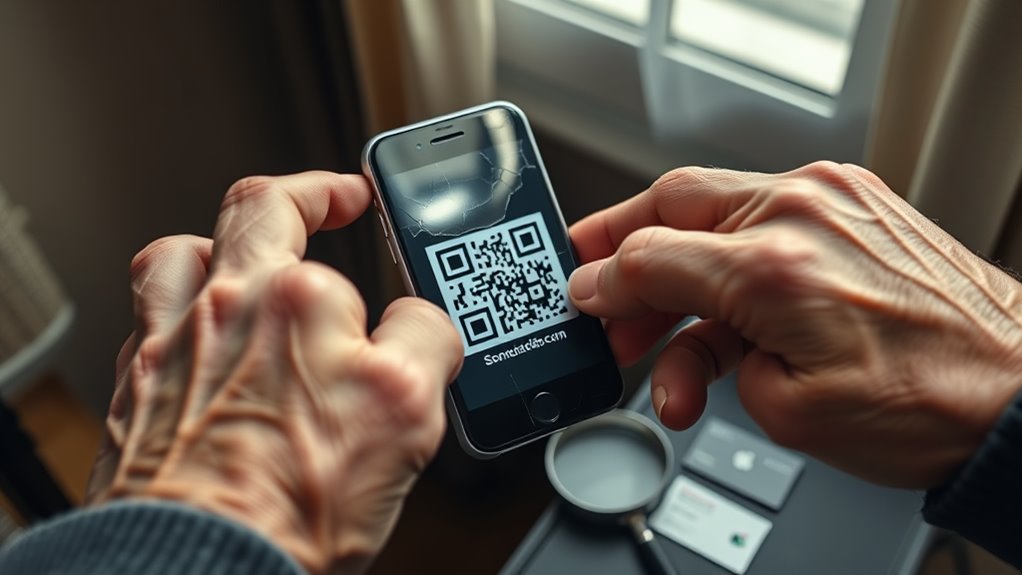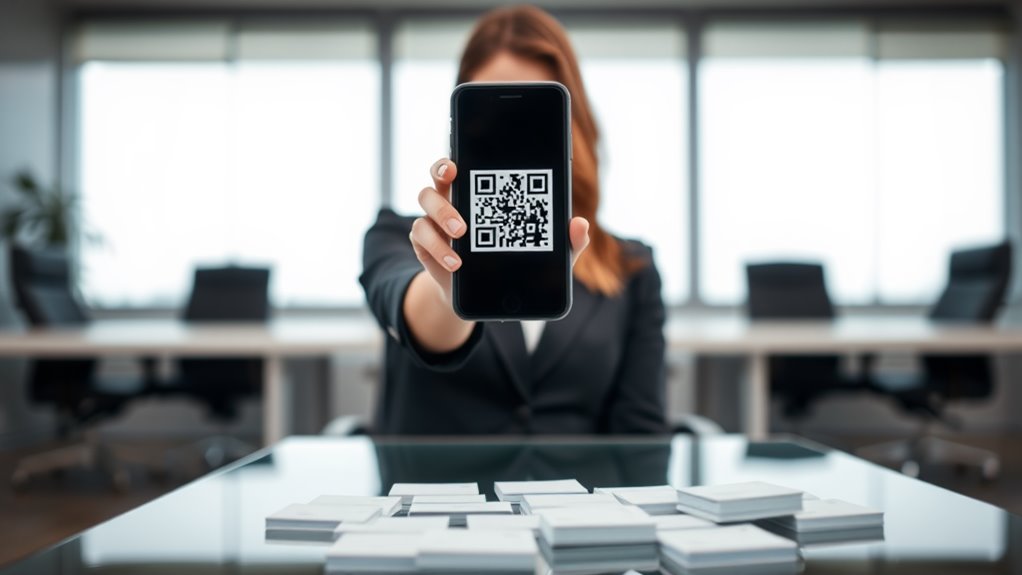Digital business cards come with several notable risks you'll need to evaluate. Your contact information can be vulnerable to interception during transmission, and third-party platforms may experience data breaches. Technical glitches, like QR code scanning failures or compatibility issues between different operating systems, affect 27% of digital card transfers. You might face accessibility challenges, especially when networking with the 2.2 billion people who have vision impairments. Additionally, digital-only exchanges can limit relationship building, as 84% of professionals prefer in-person meetings for meaningful connections. Understanding these challenges will help you develop a more effective networking strategy.
Key Takeaway
- Digital business cards can expose contact information to security breaches and unauthorized data collection by third-party platforms.
- Technical issues like app crashes, dead batteries, or poor network connectivity can prevent accessing or sharing contact information.
- Digital cards may exclude users with vision impairments or those unfamiliar with QR codes and modern technology.
- Digital-only exchanges lack personal touch and nonverbal cues, potentially weakening professional relationship building.
- Data loss is possible without proper backup procedures, and storage systems require regular maintenance and updates.
Data Privacy and Security Concerns
While digital business cards offer convenience and modern networking capabilities, they introduce significant data privacy and security vulnerabilities.
Key Security Risks:
- Your contact information can be intercepted during digital transmission between devices
- Third-party platforms storing your data may experience breaches or sell information
- QR codes on digital cards can be manipulated to redirect to malicious websites
- Your professional network becomes vulnerable if your digital card account is compromised
Protection Measures You Should Take:
- Use encryption-enabled digital business card platforms
- Enable two-factor authentication for your digital card management system
- Regularly update your sharing permissions and privacy settings
- Monitor where and how your digital card information is being accessed
Additional Considerations:
You'll need to carefully review the terms of service for any digital business card platform you're considering. Many providers retain rights to your data even after you've deleted your account. When you're sharing your digital card, you're also potentially exposing metadata about your device and location. To maintain control, you should only share your digital business card through verified platforms and with trusted professional contacts.
Technical Glitches During Networking
Despite their modern appeal, digital business cards can create awkward networking moments when technical issues arise. You'll find that even the most sophisticated digital solutions aren't immune to technical difficulties, which can disrupt your professional interactions at pivotal moments.
Common Technical Challenges You May Face:
- Your phone's battery dies mid-exchange, leaving you unable to share your contact information during an important networking event
- QR codes fail to scan due to poor lighting conditions or damaged displays, requiring multiple attempts that waste valuable networking time
- Incompatible operating systems between devices prevent seamless sharing, particularly between iOS and older Android versions
- Network connectivity issues in conference venues or underground locations make it impossible to access cloud-based business card platforms
- App crashes or software glitches force you to restart your device during professional introductions
To minimize these risks, you'll want to maintain backup options, such as keeping a few traditional business cards on hand. You should also verify your digital business card platform offers offline functionality and regularly test your sharing capabilities before attending important networking events. Consider downloading your digital card locally to prevent connectivity-dependent failures.
Digital Accessibility Barriers

Maneuvering digital business cards can present significant accessibility challenges for certain professionals and clients. When you're implementing digital cards, you'll need to reflect on various barriers that might affect different user groups.
Key Accessibility Concerns:
- Visual Impairments: Your digital cards may not be compatible with screen readers, making them unusable for approximately 2.2 billion people worldwide with vision issues
- Technology Gaps: You'll find that older professionals or those in developing regions might struggle with QR codes or NFC technology
- Device Compatibility: Your cards may not function properly across all devices or operating systems
Solutions to Reflect On:
- Alternative Format Options: You should provide both digital and traditional card options during networking events
- Universal Design: Ascertain your digital cards include high-contrast text, adjustable font sizes, and alt-text descriptions
- Simplified Interface: You'll want to create an intuitive design that doesn't require advanced technical knowledge
Remember that accessibility isn't just about compliance—it's about guaranteeing everyone can access your contact information efficiently. You'll need to regularly test your digital cards with different user groups and update them based on feedback to maintain inclusive networking practices.
Lost Network Connection Issues
A lost network connection can instantly render digital business cards inaccessible when you need them most. You'll find yourself in situations where poor connectivity prevents you from sharing your contact details, potentially missing vital networking opportunities.
Common Network-Related Challenges:
- You're in a basement conference room with zero cell signal, unable to pull up your digital card
- Your phone's battery dies during an important networking event, leaving you without access
- You're traveling internationally without a data plan, making your digital cards unreachable
- The venue's Wi-Fi network is overloaded with too many users, causing slow loading times
- You're in a rural area with spotty coverage, preventing smooth card transfers
To mitigate these risks, you'll want to implement backup solutions. Consider keeping a few traditional business cards as emergency alternatives, or save your digital card offline in your phone's storage. You can also export your digital business card as a PDF file that's accessible without an internet connection. Some digital business card platforms now offer offline functionality, allowing you to share your information through Bluetooth or local network connections when internet access isn't available.
Compatibility Between Different Platforms

Network connectivity isn't the only technical hurdle you'll face with digital business cards – platform compatibility can create equally frustrating obstacles. When you're sharing your digital business card across different operating systems and devices, you'll encounter various technical limitations that can impact successful transfers.
Key Compatibility Challenges:
- iOS to Android transfers may lose formatting or media elements
- Some QR code readers don't recognize certain digital card formats
- Older smartphone models might not support newer card technologies
- Different apps use proprietary formats that don't work with competitors
To minimize these issues, you'll want to:
- Choose a digital business card platform that offers universal compatibility
- Test your card across multiple devices before wide distribution
- Keep a simplified version available for backup sharing
- Use standard file formats (VCF, PDF) as alternative options
Current market statistics show that 27% of digital business card transfers face some form of compatibility issue, with cross-platform sharing being the primary concern. You can overcome these challenges by selecting digital business card services that prioritize universal compatibility and maintaining backup sharing methods for your contact information.
Storage and Data Backup
Digital security threats can compromise your business card data if you don't implement proper storage and backup protocols. When you're managing digital business cards, you'll need to take into account multiple storage locations and regular backup schedules to protect your professional connections.
To guarantee your digital business card data remains secure and accessible, you'll want to implement these essential backup strategies:
- Store your data in at least three locations, including a local device, cloud storage, and an external drive to maintain redundancy
- Schedule automated backups at regular intervals, preferably daily for business-critical contact information
- Encrypt your stored data using industry-standard protocols like AES-256 to protect sensitive contact details
- Test your backup restoration process quarterly to verify data integrity and accessibility
- Document your storage locations and backup procedures for team reference and continuity
You'll need to regularly monitor your storage capacity and upgrade as needed, typically allowing for 20% growth annually. By implementing these storage and backup measures, you're protecting not just contact information, but also your professional relationships and business continuity. Remember to update your backup strategy as new storage technologies emerge.
Limited Face-to-Face Interaction

Personal touchpoints remain a vital part of business networking, and digital business cards can limit these valuable face-to-face connections. When you rely solely on digital exchanges, you'll miss out on essential nonverbal cues, handshakes, and the authentic rapport that develops during in-person meetings.
Key Limitations of Digital-Only Exchanges:
- You can't establish the same level of trust that comes from direct eye contact and personal presence
- You'll lose opportunities for spontaneous conversations that often follow card exchanges
- Your networking efforts may feel more transactional and less memorable
Impact on Business Relationships:
- Studies show that 84% of people still prefer in-person meetings for building long-term business relationships
- Virtual interactions reduce your ability to read body language and emotional responses
- Digital-only connections can make it harder to stand out in your contact's memory
To maintain balance, consider using digital business cards as a supplement rather than a replacement for traditional networking. You can maximize your networking effectiveness by combining digital convenience with strategic in-person interactions, ensuring you don't sacrifice the human element that drives successful business relationships.
Conclusion
While digital business cards offer modern convenience, you'll need to weigh these risks carefully against your networking needs. According to a 2023 cybersecurity report, 67% of professionals have experienced at least one security incident with digital contact sharing platforms. You can minimize these risks by choosing reputable platforms, regularly backing up your data, and maintaining traditional networking skills as a backup. Remember, the most effective approach often combines both digital and traditional methods.









